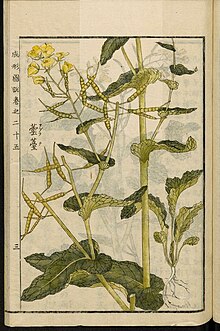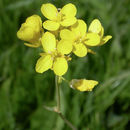Associations
provided by BioImages, the virtual fieldguide, UK
In Great Britain and/or Ireland:
Foodplant / parasite
colony of Albugo candida parasitises live, discoloured, distorted leaf of Brassica rapa
Remarks: season: spring, early autumn
Other: major host/prey
Foodplant / spot causer
amphigenous colony of Alternaria dematiaceous anamorph of Alternaria brassicae causes spots on live leaf of Brassica rapa
Foodplant / open feeder
gregarious larva of Athalia rosae grazes on leaf (underside) of Brassica rapa
Other: major host/prey
Foodplant / gall
larva of Ceutorhynchus assimilis causes gall of live root of Brassica rapa
Remarks: season: 3-
Foodplant / internal feeder
larva of Delia radicum feeds within live root of Brassica rapa
Foodplant / pathogen
colony of Erwinia carotovora infects and damages root of Brassica rapa
Other: major host/prey
Animal / pathogen
Rhizoctonia anamorph of Helicobasidium purpureum infects root of Brassica rapa
Other: major host/prey
Foodplant / feeds on
larva of Helophorus porculus feeds on Brassica rapa
Foodplant / feeds on
larva of Helophorus rufipes feeds on Brassica rapa
Foodplant / spot causer
pycnidium of Phoma coelomycetous anamorph of Leptosphaeria maculans causes spots on live cotyledon of seedling of Brassica rapa
Foodplant / spot causer
colony of Pseudocercosporella anamorph of Mycosphaerella capsellae causes spots on live leaf of Brassica rapa
Foodplant / gall
Plasmodiophora brassicae causes gall of swollen, distorted, often fused root of Brassica rapa
Other: major host/prey
Foodplant / spot causer
amphigenous Pseudocercosporella anamorph of Pseudocercosporella brassicae causes spots on live leaf of Brassica rapa
Other: major host/prey
Foodplant / spot causer
Radish Mosaic virus causes spots on live, crinkled leaf of Brassica rapa
Foodplant / spot causer
amphigenous colony of Ramularia hyphomycetous anamorph of Ramularia armoraciae causes spots on live leaf of Brassica rapa
Foodplant / pathogen
colony of Streptomyces infects and damages live twig of Brassica rapa
Foodplant / pathogen
Turnip Crinkle virus infects and damages live, crinkled, mottled leaf of Brassica rapa
Foodplant / pathogen
Turnip Mosaic virus infects and damages live, crinkled, stunted leaf (young) of Brassica rapa
Comments
provided by eFloras
Both
Brassica campestris and
B. rapa were simultaneously described by Linnaeus (Sp. Pl. 2: 666. 1753). Johann Metzger (Systematische Beschreibung der kultivirten Kohlarten. 68 pp. Heidelberg. 1833), who was the first to unite the two species, adopted
B. rapa for the combined species, and therefore this name has priority (St. Louis Code, Art. 11.5). Except for being an annual with nonfleshy taproots,
B. campestris is absolutely indistinguishable from the biennial
B. rapa with fleshy taproots. In fact, plants of
B. rapa that escape from cultivation fail to produce fleshy roots. Therefore,
B. campestris deserves no higher than a varietal rank of
B. rapa, and it is here reduced to synonymy under var.
oleifera.
Forms with 3- or 4-valved fruit have been recognized as Brassica trilocularis Roxburgh and B. quadrivalvis J. D. Hooker & Thomson, respectively. They were treated by Jafri (Fl. W. Pakistan 55: 24. 1973) as subspecies of B. napus, but both have 2n = 20, and therefore they should be recognized as a variety of B. rapa. Of the six varieties recognized in B. rapa, the following four are grown and naturalized in China.
- license
- cc-by-nc-sa-3.0
- copyright
- Missouri Botanical Garden, 4344 Shaw Boulevard, St. Louis, MO, 63110 USA
Description
provided by eFloras
Herbs annual or biennial, 30-120(-190) cm tall, glabrous or sparsely pubescent basally, rarely glaucous, sometimes with fleshy taproots. Stems erect, simple or branched above. Basal and lowermost cauline leaves petiolate, not rosulate or obscurely to strongly rosulate and forming a compact, oblong head; petiole (1-)2-10(-17) cm, slender or thickened and fleshy, sometimes strongly winged; leaf blade ovate, oblong, or lanceolate in outline, (5-)10-40(-60) × 3-10(-20) cm, margin entire, repand, dentate, or sinuate, sometimes pinnatifid or pinnatisect and with a large terminal lobe and smaller, 1-6, oblong or ovate lateral lobes on each side of midvein. Upper cauline leaves sessile, ovate, oblong, or lanceolate, 2-8(-12) × 0.8-3 cm, base amplexicaul, deeply cordate, or auriculate, margin entire or repand. Fruiting pedicels, straight, ascending or divaricate, (0.5-)1-2.5(-3) cm. Sepals oblong, (3-)4-6.5(-8) × 1.5-2 mm, ascending. Petals bright yellow, rarely pale or whitish yellow, 7-10(-13) × (2.5-)3-6(-7) mm, obovate, apex rounded. Filaments 4-6(-7) mm; anthers oblong, 1.5-2 mm. Fruit linear, (2-)3-8(-11) cm × 2-4(-5) mm, terete, sessile, divaricate or ascending; valvular segment (1.3-)2-5(-7.5) cm, 8-15-seeded per locule, valves with a prominent midvein; terminal segment conical, (0.3-)1-2.5(-3.5) cm, seedless or rarely 1-seeded; style obsolete. Seeds dark or reddish brown, globose, 1-1.8 mm in diam., minutely reticulate. Fl. Mar-Jun, fr. Apr-Jul. 2n = 20*.
- license
- cc-by-nc-sa-3.0
- copyright
- Missouri Botanical Garden, 4344 Shaw Boulevard, St. Louis, MO, 63110 USA
Habitat & Distribution
provided by eFloras
Cultivated. Throughout China [widely cultivated and naturalized elsewhere].
- license
- cc-by-nc-sa-3.0
- copyright
- Missouri Botanical Garden, 4344 Shaw Boulevard, St. Louis, MO, 63110 USA
Brief Summary
provided by EOL authors
Brassica rapa, field mustard, is an herbaceous annual or biennial species in the Brassicaceae (the cabbage or mustard family) from which various interrelated vegetable varieties have been developed, including turnips, bok choi, pak choi, tat soi (which are sometimes referred to as Chinese cabbages, or Chinese white- or Chinese flat cabbages, or celery mustard), pak choi sum (Chinese flowering cabbage), and napa cabbage (also called celery cabbage or pe tsai), among others. The species is thought to have originated in Europe, with many varieties developed in Asia, but its numerous varieties are now widely cultivated commercially and in home gardens in temperate and north temperate regions throughout the world. Some varieties have become naturalized and are considered weeds in regions of China and North America. B. rapa, formerly known as B. campestris, shows considerable variation in growth form and characteristics across the many cultivars, this species has, in general, a flat or globose root (in the case of turnips) without an elongated crown (as found in the rutabagas and kohlrabi, which are derived from B. olearacea), with stems that grow typically grow 30 to 120 cm (11.75 to 47.25 in), although in some cultivars up to 190 cm (75 in) tall. The leaves are large, soft, smooth or soft-hairy leaves, up to 50 cm (20 in) long, pinnatifid (deeply lobed) or lyrate (deeply lobed, but with an enlarged terminal lobe and smaller lateral lobes), which clasp the stem and may form a more or less dense head. The yellow, four-parted and cross-shaped flowers are small, usually less than 2 cm (0.75 in) long, and produce siliques—capsular fruit that dehisces (splits open) when mature—that may be up to 6 cm (2.5 in) long. With a long history of cultivation and diversification into many varieties with numerous and overlapping common names, it can be difficult to ascertain and classify the relationships among species and varieties (or subspecies). Varieties of B. rapa are generally placed into 4 major categories: 1) var. chinensis, which includes pak choi, bok choi, and tat soi, cultivars that originated in southeast Asia and have long been cultivated in China and Japan, where they are also widely naturalized. These form compact clusters of stems that are not as densely packed as in cabbage heads. The whole young plants are used for their leafy greens and fleshy green or white stems, either salted and fermented into a pickle known as pak choi can, or cooked in soups, stir-fries, and noodle dishes. 2) var. parachinensis, Chinese flowering cabbage (sometimes called Chinese broccoli, although that name generally refers to the related B. olearacea var. alboglabra), which has elongated fleshy stems and flowering shoots that do not form into tight clusters or heads. The flowering stems, along with their leaves and buds, are pickled or prepared as a cooked vegetable in numerous Asian dishes. 3) var. pekinensis, napa or celery cabbage (sometimes known as Peking cabbage or pe tsai), which may either have a dense head of flat-stemmed leaves, or may form simply a loose cluster of fleshy stemmed leaves. These varieties have a long history of cultivation in China, Japan, and Korea, where they are used in salads, soups, and as a cooked vegetable. This variety is commonly used to make the traditional Korean fermented cabbage dish, kimchee. 4) var. rapa, turnips, which have a fleshy, globe-shaped root. Described in Roman accounts dating to 400 B.C., they are one of the oldest cultivated root crops, and are still widely used in Europe, prepared raw or cooked in soups, stews, and sautés. The young leaves are also used as cooked greens. (Bailey et al. 1976, Flora of China 2012, Hedrick 1919, van Wyk 2005.)
Brassica rapa: Brief Summary
provided by wikipedia EN

Illustration of Brassica rapa from the Japanese agricultural encyclopedia Seikei Zusetsu
Brassica rapa is a plant species growing in various widely cultivated forms including the turnip (a root vegetable); Komatsuna, napa cabbage, bomdong, bok choy, and rapini.
Brassica rapa subsp. oleifera is an oilseed which has many common names, including rape, field mustard, bird's rape, and keblock. The term rapeseed oil is a general term for oil from Brassica species. Food grade oil made from the seed is also called canola oil, while non-food oil is called colza oil. Canola oil is sourced from three species of Brassica plants: Brassica rapa and Brassica napus are commonly grown in Canada, while Brassica juncea (brown mustard) is a minor crop for oil production.
- license
- cc-by-sa-3.0
- copyright
- Wikipedia authors and editors


 Illustration of Brassica rapa from the Japanese agricultural encyclopedia Seikei Zusetsu
Illustration of Brassica rapa from the Japanese agricultural encyclopedia Seikei Zusetsu